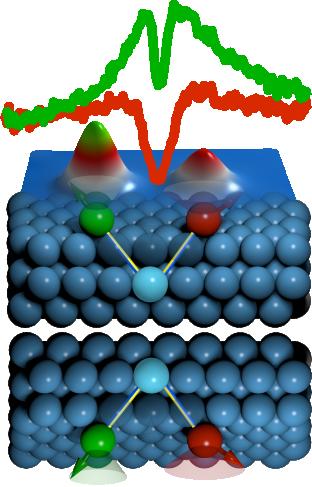Handshake of atoms: lefties or righties?

The Figure shows a pair of magnetic iron atoms on top of a platinum crystal surface as “seen” with a scanning tunneling microscope (hillocks). The spectra of the left and right atom (green and red lines), taken with the same microscope, show characteristic gaps, that tell the scientists a clockwise rotation of the atoms’ magnetization exists, as illustrated by the clockwise rotation of the arrows from the green to the red sphere representing the iron atoms. The reason for this right-handedness is a peculiar magnetic handshake mediated by the platinum atoms in the substrate (blue spheres) below the iron pair which breaks the mirror symmetry, as apparent from the mirror image on the bottom. University of Hamburg
Handedness is a peculiar breaking of symmetry where a mirror image of a structure or pattern is different from its original. While the most well-known example is our own hand, which gave the name to this kind of asymmetry, there are many other materials or structures known from different disciplines of natural sciences which show handedness: Amino acids and sugars, snail shells, and swirls of the magnetization, so called skyrmions, which have recently been heavily investigated because of their promise as new units for the storage of bits in information technology.
In all of these structures, we can differentiate righties and lefties, which are mirror images of each other. While in some of these examples lefties and righties are almost equally represented in nature, in many others one sort of handedness is dominating. Scientists have since wondered about the possible origin of this so called homo-chirality, and it has been even proposed that evolutionary processes are responsible for handedness in some systems.
The Hamburg research team has now explored the source of magnetic handedness in the smallest possible units. By observing a pair of iron atoms, which are lying on a platinum crystal, with a scanning tunneling microscope (see Figure) they were able to deduce a clockwise rotation of the magnetization, i.e. the pair is right-handed.
Moreover, moving the right atom by only one atomic diameter farther apart from the left atom changes the rotation of the magnetization from clockwise to anti-clockwise, i.e. the pair gets left-handed. Together with the theory group of the Forschungszentrum Jülich, the team was able to show that the mechanism responsible for this handedness is a magnetic handshake between the two atoms mediated by the platinum substrate atoms (see the Figure).
The researchers now hope that they can use the tip of the scanning tunneling microscope as a tool in order to build lattices of hundreds of such iron atoms, which might then host left- or right-handed skyrmions.
Original publication:
Tailoring the chiral magnetic interaction between two individual atoms
A. A. Khajetoorians, M. Steinbrecher, M. Ternes, M. Bouhassoune, M. dos Santos Dias, S. Lounis,
J. Wiebe, and R. Wiesendanger,
Nature Communications 7, 10620 (2016).
DOI: 10.1038/NCOMMS10620
Further Information:
Heiko Fuchs
Sonderforschungsbereich 668
Universität Hamburg
Jungiusstr. 9A, 20355 Hamburg
Tel.: (0 40) 4 28 38 – 69 59
Fax: (0 40) 4 28 38 – 24 09
E-Mail: hfuchs@physnet.uni-hamburg.de
Media Contact
All latest news from the category: Information Technology
Here you can find a summary of innovations in the fields of information and data processing and up-to-date developments on IT equipment and hardware.
This area covers topics such as IT services, IT architectures, IT management and telecommunications.
Newest articles

Properties of new materials for microchips
… can now be measured well. Reseachers of Delft University of Technology demonstrated measuring performance properties of ultrathin silicon membranes. Making ever smaller and more powerful chips requires new ultrathin…

Floating solar’s potential
… to support sustainable development by addressing climate, water, and energy goals holistically. A new study published this week in Nature Energy raises the potential for floating solar photovoltaics (FPV)…

Skyrmions move at record speeds
… a step towards the computing of the future. An international research team led by scientists from the CNRS1 has discovered that the magnetic nanobubbles2 known as skyrmions can be…





















